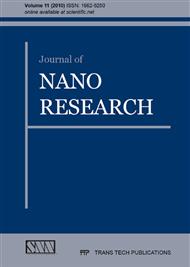p.25
p.35
p.39
p.45
p.57
p.67
p.73
p.79
p.85
Investigation on Fabrication of W-Cu Nanocomposite via a Thermochemical Co-Precipitation Method and its Consolidation Behavior
Abstract:
W-25%Cu nanocomposite was produced via a thermochemical co-precipitation procedure. Copper nitrate and sodium tungstate salts were used as Cu and W containing precursors respectively. Aqueous solutions of these salts were reacted under controlled pH condition prepared by ammonia addition and the resulting precipitates were then calcined at 450oC and hydrogen reduced at 800oC. The products of each step were characterized by XRD and Electron Microscope. Using a basic medium with a pH of 13 which caused the formation of complex Cu(NH3)42+ was found to provide suitable condition for precipitation of nanosized composite powders. Cu2WO4(OH)2 and CuWO4.2H2O as raw precipitates, CuWO4-x , CuO, and WO3 as calcined powders, and W-Cu reduced composite powders, all were seen to keep nanosize dimensions through high temperature treatments of fabrication. Sintering of the reduced powders at the temperature of 1150oC led in a density of about 98% theoretical density.
Info:
Periodical:
Pages:
57-66
Citation:
Online since:
May 2010
Price:
Сopyright:
© 2010 Trans Tech Publications Ltd. All Rights Reserved
Share:
Citation:


